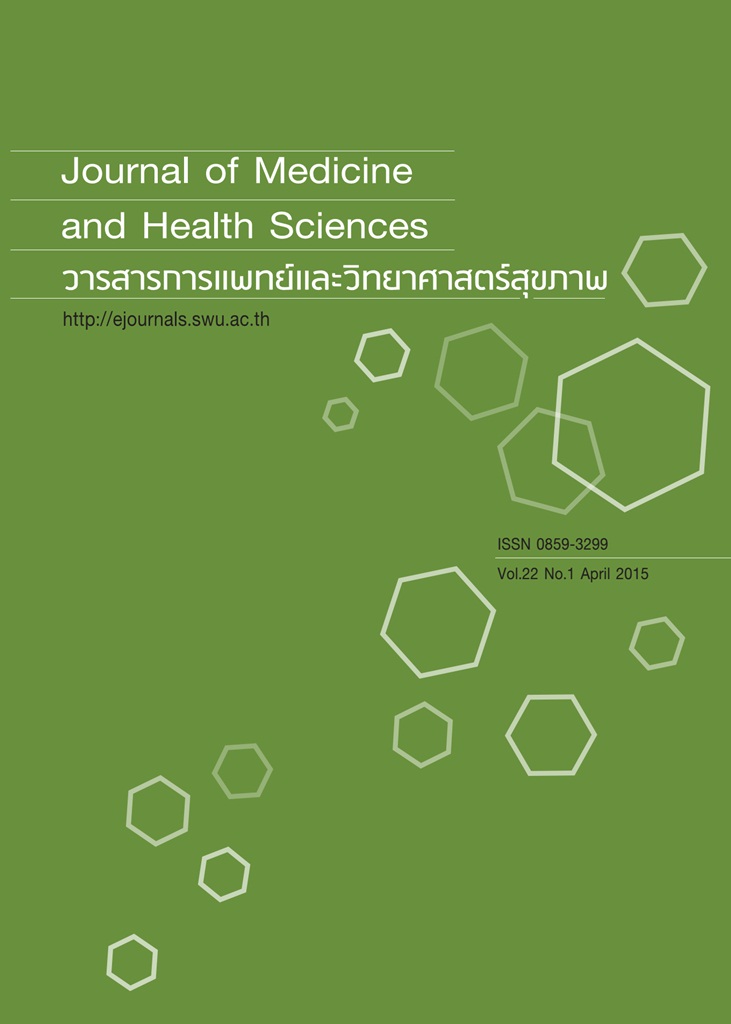Causative Organisms in Neonatal Sepsis in Neonatal Intensive Care Unit of HRH Princess Maha Chakri Sirindhorn Medical Center
Keywords:
การติดเชื้อในเลือด, เชื้อก่อโรค, ผลของการตอบสนองต่อยาต้านจุลชีพ, neonatal sepsis, causative organisms, antimicrobial susceptibilityAbstract
Neonatal sepsis is the most serious problem in the neonatal intensive care (NICU) with highly significant morbidity and mortality among infants. The study was to determine the causative organisms in neonatal sepsis at NICU of HRH Princess Maha Chakri Sirindhorn Medical Center (MSMC), Ongkharak, Nakhon-Nayok. A retrospective chart review for 5 years during January 1, 2007 to December 31, 2011 in neonates with clinical suspicious signs and symptoms of sepsis and positive blood culture admitted to MSMC was investigated. The results showed that a total of 2,087 neonates admitted to NICU over a period of 5 years with 124 episodes of sepsis from 102 neonates (males: females = 1.2:1) who had clinical suspicious signs and symptoms of sepsis and positive blood culture. The incidence rate of septicemia was 11.9 per 1,000 patients admitted year. Forty percents were classified as early neonatal sepsis (EOS) and sixty percents were classified as late neonatal sepsis (LOS). There were 2 cases developed meningitis and the mortality was seen in 6 cases which mainly associated with gram negative organisms. The most common organisms in EOS were Coagulase negative Staphylococcus (CONS) followed by Enterobacter spp and A. baumannii. That of LOS were CONS followed by Enterobacter spp and K. pneumoniae. Sensitivity of gram positive organisms to vancomycin, fosfomycin, chloramphenicol and ciprofloxacin was 100%, 90.4%, 84.2% and 69.6% respectively whereas that of gram negative organisms to meropenem, ciprofloxacin and amikacin was 94%, 81.6% and 81.2% respectively. For gram negative organisms and third generation cephalosporins, sensitivity to cefoperazone, ceftazidime, ceftriaxone and cefotaxime was 71.4%, 36.7%, 22.4% and 14.2% respectively. Identification of the causative organisms and antimicrobial susceptibility helps the physician to choose the most appropriate empirical treatment.
เชื้อที่เป็นสาเหตุของการติดเชื้อในเลือดในผู้ป่วย ทารกแรกเกิดที่รับรักษาในหออภิบาลทารกผู้ป่วยหนัก ศูนย์การแพทย์สมเด็จพระเทพฯ
โรคติดเชื้อยังเป็นปัญหาและเป็นสาเหตุการตายที่สำคัญในทารกแรกเกิด การศึกษานี้เพื่อหาเชื้อที่เป็นสาเหตุของ การติดเชื้อในเลือดในทารกแรกเกิดที่รับรักษาในหออภิบาลทารกผู้ป่วยหนัก ศูนย์การแพทย์สมเด็จพระเทพฯ ทำการศึกษา ย้อนหลัง 5 ปีโดยเก็บรวบรวมข้อมูลจากเวชระเบียนทารกแรกเกิดที่ตรวจพบเชื้อในเลือดร่วมกับมีอาการหรืออาการแสดง ของการติดเชื้อระหว่าง วันที่ 1 มกราคม 2550 ถึงวันที่ 31 ธันวาคม 2554 ผลการศึกษาพบว่ามีทารกที่ได้รับการรักษา จำนวน 2,087 คน ตรวจพบการติดเชื้อในเลือด 124 ครั้ง จากทารก 102 คน เพศชายต่อเพศหญิง 1.2:1 คิดเป็น 11.9 ต่อ 1,000 คน ของทารกที่รับไว้รักษาทั้งหมดในหออภิบาลทารกผู้ป่วยหนัก เป็นการติดเชื้อในระยะแรกร้อยละ 60 และ ระยะหลังร้อยละ 40 มีทารกติดเชื้อในเยื่อหุ้มสมองร่วมด้วยจำนวน 2 คน ทารกเสียชีวิต 6 คน ส่วนใหญ่เสียชีวิตจากการ ติดเชื้อแบคทีเรียแกรมลบ เชื้อก่อโรคที่เป็นสาเหตุของการติดเชื้อในระยะแรกคือ Coagulase negative Staphylococcus (CONS) รองลงมา Enterobacter spp และ A. baumannii เชื้อก่อโรคที่เป็นสาเหตุของการติดเชื้อในในระยะหลังคือ CONS รองลงมา Enterobacter spp และ K. pneumoniae ผลของการตอบสนองต่อยาต้านจุลชีพของเชื้อแบคทีเรียแกรมบวก vancomycin, fosfomycin, chloramphenicol และ ciprofloxacin คือ ร้อยละ 100, 90.4, 84.2 และ 69.6 ตามลำดับ ผลของการตอบสนองต่อยาต้านจุลชีพของเชื้อแบคทีเรียแกรมลบ meropenem, ciprofloxacinและ amikacinคือร้อยละ 94, 81.6 และ 81.2 ตามลำดับ ผลของการตอบสนองต่อยากลุ่มthird generation cephalosporin เพื่อต้านเชื้อจุลชีพของ แบคทีเรียแกรมลบ cefoperazone, ceftazidime, ceftriaxoneและcefotaximeคือร้อยละ71.4,36.7,22.4และ14.2 ตามลำดับ การทราบชนิดของเชื้อก่อโรคในเลือด และผลการตอบสนองต่อยาต้านจุลชีพของเชื้อทำให้แพทย์ผู้ดูแลสามารถ เลือกใช้ยาต้านจุลชีพได้อย่างเหมาะสม



